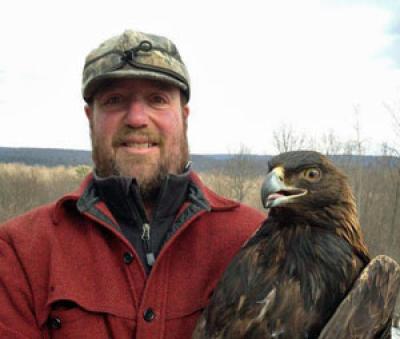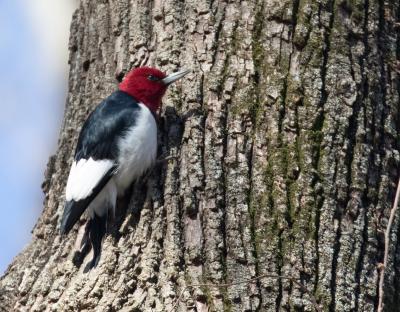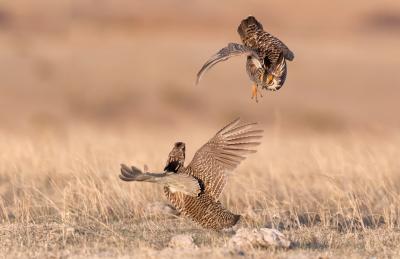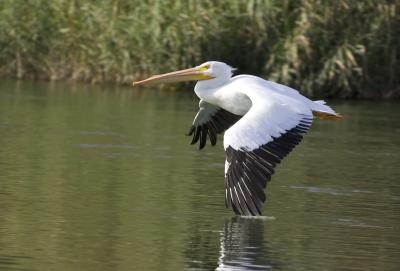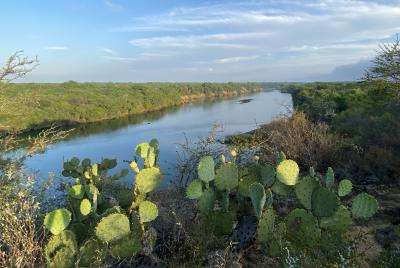Minnesota in Winter
-
Jan 15-20, 2026
Frank Nicoletti
2026
Single Room Supplement $530
2026
Single Room Supplement $530
Traveling to Minnesota in the depth of winter may seem to defy reason, but for the birdwatcher, the season and place combine to produce a mouth-watering array of species. Northern owls always inspire the greatest interest; we’ll look for Snowy, Great Gray, and Northern Hawk Owls, and if we’re particularly lucky, we may find a Boreal Owl. Sharp-tailed and Ruffed Grouse are usually easier to find at this season, when energy demands dictate that they feed frequently and often conspicuously during daylight hours, and we have a reasonable chance at Spruce Grouse. Past tours have recorded as many as six species of woodpeckers, including Black-backed and American Three-toed, and the standard cadre of regular winter finches—Pine and Evening Grosbeaks, Red Crossbill and Common Redpoll—are sometimes augmented by less predictable species including White-winged Crossbill and Hoary Redpoll. And if regular winter residents such as Northern Shrike, Gray Jay, Boreal Chickadee, and Bohemian Waxwing weren’t enough, each year seems to harbor a surprise or two. Recent tours have recorded Ivory and Slaty-backed Gulls, Harlequin Duck, and Townsend’s Solitaire. There are also some great mammals—we’ve seen Moose on half our winter trips. We have also seen Gray Wolf at close range, and once a Lynx!
Weather conditions, including temperature and snow depth, vary from year to year. Food resources, and by extension bird population levels, fluctuate as well, so no two consecutive winters are the same. The weather can be challenging, with wind, snow, and sub-zero temperatures possible, but by dressing appropriately we’ll find deep winter surprisingly manageable, the landscape beautiful, and the birds well worth the effort. Our itinerary will remain flexible, allowing us to travel to the places where our target birds are most likely to be found.
Day 1: The group will convene around noon at Minneapolis-St. Paul airport. We’ll begin with a few birding stops on the way to Duluth, where we’ll be based for five nights.
Days 2-5: The vast boglands north and west of Duluth offer some of the best winter birding in the country. Highlights include the possibility of Great Gray and Northern Hawk Owls, two species that are present each winter in varying numbers. We’ll keep a look out for these nomads throughout the tour, but the so-called Sax-Zim bog will provide some of our best chances. The habitat in these regions is also ideal for Sharp-tailed and Ruffed Grouse, while adjacent open farmland hosts Black-billed Magpie, here at the eastern edge of its range, and Northern Shrike. In years with less snow, Snow Bunting and Rough-legged Hawks can be found. We'll spend another day north of the scenic Lake Superior harbor town of Two Harbors, with a visit to the secluded boreal woodlands near the hamlet known as Isabella. This region is one of the most reliable haunts for some of Minnesota’s most sought-after winter birds and our efforts will focus on two in particular: Spruce Grouse and Black-backed Woodpecker. We’ll also look for Gray Jay, Boreal Chickadee and the enigmatic winter finches, including Pine and Evening Grosbeaks, Common and perhaps Hoary Redpolls, as well as Red and White-winged Crossbills.
The birding in and around Duluth and other towns along the north shore of Lake Superior can also be surprisingly productive. Ornamental plantings attract fruit-eaters including Bohemian Waxwings, which are sometimes seen by the thousands (although we’d expect smaller numbers). These fruiting trees have in the past also attracted Townsend’s Solitaire and Varied Thrush, both rare but regular winter visitors. We’ll scour the barren icescapes of the frozen Duluth-Superior harbor for Snowy Owl. We’ll also visit Canal Park, which is tended by hundreds of gulls when conditions are right. If gulls are present, we can expect Glaucous and Iceland (Thayer’s) and hope for rarities; in 2008 we saw a Slaty-backed Gull. Although our focus will be on birds, our travels through northern Minnesota may include encounters with Mink, Pine Marten, Fisher, Porcupine, Moose, or, if we’re very lucky, Gray Wolf or Lynx. Nights in Duluth.
Day 6: This morning we’ll make our way back to Minneapolis, with a bit of birding on the way to the airport where the tour concludes at noon.
Note: The information presented below has been extracted from our formal General Information for this tour. It covers topics we feel potential registrants may wish to consider before booking space. The complete General Information for this tour will be sent to all tour registrants and of course supplemental information, if needed, is available from the WINGS office.
ENTERING THE UNITED STATES: Non-U.S. citizens will need a valid passport and may need a tourist visa. Consult your nearest U.S. Embassy or consulate for details. Canadian citizens should carry proof of citizenship in the form of a passport or birth certificate.
PACE OF THE TOUR: At this time of year at this northern latitude the sun rises relatively late (approximately 7:30). We may have to drive as much as an hour and a half to reach our first birding stop of the day, however, so we’ll rise early enough to factor in driving time. The sun sets relatively early in the evening (approximately 5:30) so our days in the field will not seem especially long and we should be able to turn in early enough each night to allow a good night’s sleep. There will be moderately long drives between destinations on several days.
Breakfasts are at our hotel. Lunches will most often be taken at small cafés, which give us time to warm up and absorb a bit of local flavor. Barring unforeseen circumstances, suppers will be relaxed sit-down affairs in nice restaurants near the hotel.
More time is spent in the vehicles than on most tours. We will try to get out and walk when the opportunity presents itself. We will rotate seats in the vehicle(s) on a daily basis so everyone will have the opportunity to bird from every seat. When not in the vehicle, with few exceptions, birding will be done from plowed roads and walk-able trails, usually near the vehicle itself. Any walks through snow will be fairly short and will always be optional.
HEALTH: Birdwatching in Minnesota in the winter poses no major health hazards. The most obvious issue is dealing with potentially very cold weather. Having said this, by dressing appropriately, we’ll find deep winter surprisingly manageable. It is of the utmost importance, however, that you come prepared for cold weather.
Smoking: Smoking is prohibited in the vehicles or when the group is gathered for meals, checklists, etc. If you are sharing a room with a nonsmoker, please do not smoke in the room. If you smoke in the field, do so well away and downwind from the group. If any location where the group is gathered has a stricter policy than the WINGS policy, that stricter policy will prevail.
CLIMATE: Average winter temperatures for this time of year range from 0° F to 30° F (-18° to -1° C) although we would expect some variation. Rarely, temperatures plunge well below 0° F – we’ve had -30° F several times - or rise into the mid- to upper 30s F (2° to 4° C). In open spaces wind-chill can be a factor but wind is rarely an issue in more closed, forested areas. Snow is possible and expected at any time.
ACCOMMODATIONS: We will be staying in one comfortable hotel throughout the trip. It’s on the shore of Lake Superior and sometimes presents some nice birding opportunities for gulls and waterbirds. It is within close walking distance of several restaurants.
FOOD: Food is North American standard.
Food Allergies / Requirements: We cannot guarantee that all food allergies can be accommodated at every destination. Participants with significant food allergies or special dietary requirements should bring appropriate foods with them for those times when their needs cannot be met. Announced meal times are always approximate depending on how the day unfolds. Participants who need to eat according to a fixed schedule should bring supplemental food. Please contact the WINGS office if you have any questions.
TRANSPORTATION: We will be traveling by leader-driven 15-passenger window van or minivan, depending on the group size. When using 15-passenger window vans, we take a maximum of seven passengers plus the leader/driver. Participants should be able to ride in any seat in the vehicle.
2025 Narrative
In Brief:The expansive bog lands, boreal forests, and Lake Superior shorelines of Duluth, Minnesota and environs offer a uniquely accessible opportunity to see specialty birds of the northern climes in winter. Because of the nature of the boreal ecology, being comprised of relatively few species, the presence and abundance of northern birds such as owls and finches hinges on the presence and abundance of a few or even a single food source. The cyclical crops of spruce and fir cones, for example, or the fluctuating populations of voles, determine to a large extent the numbers and species of birds that are able to survive the winter in a given area. Rather than undergoing predictable migrations, these northern species are erratic - wandering the expanse of the boreal forest and settling where food is most abundant, or in some years, not moving at all. Occasionally, a number of factors line up and an area like northern Minnesota will experience a veritable bird “event”, a great irruption of birds otherwise scarce or absent. Even in a year that could be said to be an “off” year for some of these northern nomads, we nevertheless enjoyed memorable encounters with many of the birds and mammals that make winter in the north so enticing to birders: Great Gray, Boreal, Northern Hawk Owl and Snowy Owls, Pine Grosbeak, and Bohemian Waxwings to name a few. We even added two new species to the all-time tour list: Trumpeter Swan and Short-eared Owl!
In Detail: On January 16, after picking up the group at the Minneapolis airport, we started the tour with some birding in and around the Twin Cities. We enjoyed watching Trumpeter Swans and other waterfowl on sections of the Mississippi River. We were unsuccessful with finding Northern Saw-whet and Long-eared Owl but we spent the last two hours of the afternoon watching Short-eared Owls hunting and calling, barking at each other with an amazing sunset. It was a highlight for the day!
We then traveled north to our hotel in Duluth, the Hampton Inn, and then walked next door for a nice dinner at the Canal Park Brewery. We discussed the upcoming days and planned a strategy. I had my plan laid out and knew what everyone hoped to see. I was excited to show the group the beauty of northern Minnesota and all the wonder it holds.
On January 17, our second day of birding, we traveled to the Sax-Zim Bog in search of Great Gray Owls and other bog specialties. We managed excellent views of a Great Gray Owl and picked up some other birds which included Northern Shrike, Black-billed Magpie, White-winged Crossbill, Common Redpolls and Canada Jay.
The next day, we ventured around the back roads of Duluth to Two Harbors in search of owls. The group was less concerned about birding the lakeshore for the few species of waterfowl and gulls that were around. We managed to find 8 Great Grays, 5 Boreal Owls, a Northern Hawk Owl and a Snowy Owl! I discussed the ecology of the owl irruption explaining the causes and how the irruption occurs every 3-5 years with the vole population crashing up north.
On January 19, we went up to the Superior National Forest near Tofte and up to Grand Marais. Our second day of extreme cold weather which bottomed out at -35 degrees and windchill approaching 50 below! It was tough conditions for the birds and for us, too, but we managed to find a pair of American Three-toed Woodpeckers and a single Black-backed Woodpecker along with the only Boreal Chickadee seen on the tour. We were able to find all 6 species of woodpeckers!! And added two more Great Grays to our trip.We found some feeders in Grand Marais and added a few species to the trip list, but we were very excited when we came across a flock of twenty Bohemian Waxwings which have been mostly absent this winter in Minnesota.
On January 20, we started again back up to Sax-Zim Bog where we were able to watch Great Gray Owls hunting. We saw many of the regular birds already seen earlier on the tour but better views of most of them this time. We watched another Boreal Owl as it searched for voles, watching it alertly searching and listening for them below the snow. Another highlight was observing two adult Goshawks chasing each other into the woods and then disappearing.
We left our hotel on the early morning of January 21, and on our way down the freeway to the Twin Cities, we spotted another Boreal Owl, the 7th of the tour!
Thank you for visiting our beautiful neck of the woods. I hope you all enjoyed the birds, ecology, history and mammals of the region. Come back and visit again soon!
- Frank Nicoletti
Not only is Frank a great birder, he also has excellent people skills. This tour is enjoyable thanks to him!
- Shin-ju Y. on Minnesota in Winter
I cannot think of anything else to improve this tour. Frank was an excellent leader and very knowledgeable about the area and where to locate target species. He was always concerned about our welfare and made sure that everyone always saw the birds. His instructions to us were always clear and easily understood. I really appreciated the excellent instructions in the pre trip packet on what to wear for this trip.
- Karen T. on Minnesota in Winter
Frank did an incredible job. His knowledge of the area is outstanding. He knew where to go, and he used his extensive network of birding acquaintances to help us find the birds.
- Marc R. on Minnesota in Winter
Fabulous tour. The owls cooperated! Frank is a wonderful leader. He knows the area extremely well and finds the birds that you want to see. He is concerned about your well being. A great value.
- Karyn D. on Minnesota in Winter
Maximum group size seven with one leader.




























